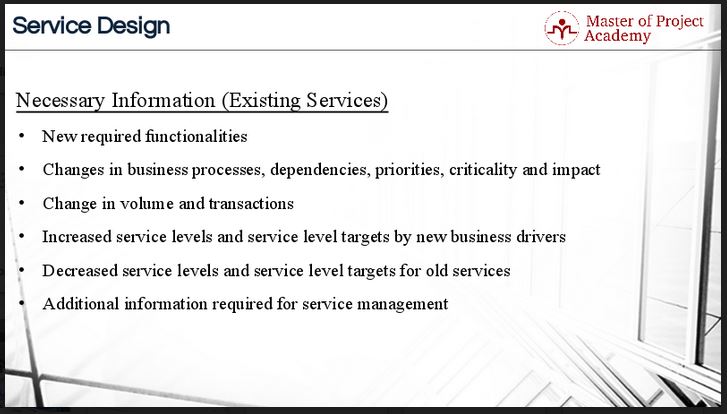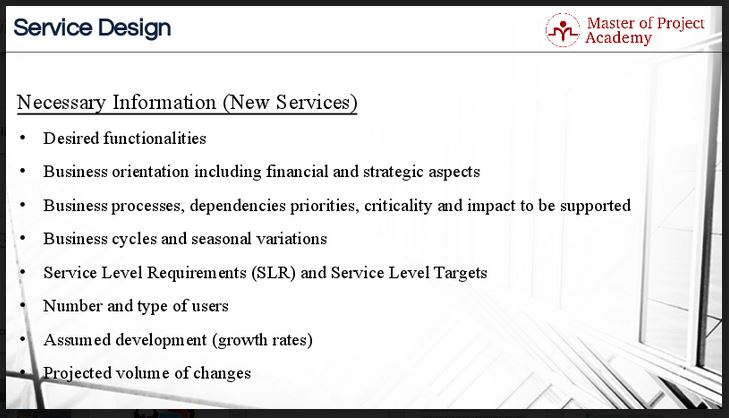Identification of Business Requirements is an important part of the ITIL Service Design stage of the ITIL Service Lifecycle as discussed in ITIL online courses. The IT Service owner needs to know the business requirements to be able to offer a service catalog with acceptable service quality. ITIL foundation training teaches that new services or updates to existing services are done mainly based on business requirements in order to improve the customer satisfaction.
Therefore, business requirements need to be assessed and evaluated carefully during ITIL Service Design stage. Why a new service is requested or why an update in an existing service is required need to be assessed carefully. The main reason or the ultimate goal of the requirement must be known to offer a good service quality to the customer. It’s also critical to know what is required to design excellent new services or service upgrades.

Setting objective targets
IT must create a close information relationship to the business. When receiving new business requirements, all details and open points of the business requirements should be addressed and tied up before starting to the design process.
For instance, let’s consider that the business requirement is that the money withdrawal process from the bank should be very fast and even faster than the competitor banks. Is this an acceptable requirement? NO! Fast, slow, good, bad; these are qualitative and subjective evaluations or experiences of a customer. One minute can be very fast for money withdrawal process for a customer and it can be very long for another customer.
Therefore, business requirements must be identified clearly and concisely before initiating the designs for new services or changes to existing services. For instance, finalizing a money withdrawal process in less than fifteen seconds is a more clear, quantitative and objective example of business requirements.
The objective
The main objective of the identification of the business requirements is to understand the customer’s operational, tactical and strategic requirements. Service providers produce goods or services for the use of its customers and if these goods or services meet the requirements of the customers, both the customers and the service provider will be happy: a win-win situation. This will ensure sustainable business for the service provider organization. This is why clear business requirements must be identified.
The identification of business requirements needs to be applied both to new services and to changes to existing services. Whether there will be a new service development or update to an existing service, business requirements must be gathered clearly and concisely before initiating the Service Design stage of the ITIL Lifecycle.
Business requirements for changing existing services

Business requirements might call for a new functionality in an existing service. For instance, money withdrawal process is an existing service of a bank. When a customer wants to withdraw one hundred dollars from the ATM, the business requirement may be to give an option to the customer to withdraw five twenty dollar banknotes, or two fifty dollar banknotes or one one-hundred banknote. This is a new requirement to the existing money withdrawal service. The IT organization will need to update its services to give the money to the customer based on his preference. This brings about changes in business processes, dependencies, priorities. The same applies to new requirements on existing services. For instance, calls to the police are free in some countries while it is charged in other countries. If the business requires the police to be called for free, this a change in existing service.
The same applies to new requirements on existing services. For instance, calls to the police are free in some countries while it is charged in other countries. If the business requires the police to be called for free, this a change in existing service.
Sometimes new business requirements will mean that there will be a change in volume and transactions. Let’s consider a telecom operator that delivers up-to-date finance news to its customers as a text message. If lots of new subscribers are demanding this service, the operator needs to increase its infrastructure capabilities, server capacities, the number of administrators monitoring these services etc. Resources must be considered during the Service Design stage to meet business requirements during the development of updates to existing services.
Changes in service levels and service level targets may be required if changes are made to an IT service due to new business requirements. Let’s imagine that 98% availability is the agreed service level for a service between the business and IT. Depending on the business and requirements of the customer, if the business requests to increase the availability of this service to 99% availability, this will be a new requirement for an existing service.
Business requirements for developing new services

First of all, the desired functionalities of new services need to be acquired from the business requirements. For instance, if the business requirement is to install new customer recognition technology at ATMs, the type of recognition service must be identified as a business requirement. What will be the customer recognition services for new ATMs of the bank? Fingerprint recognition, face detection system, password diagnosis; these are examples of desired functionalities for the new ATMs of a bank.
Business orientation including financial and strategic aspects of the new services should be clear and concise as well. An example of business requirements that must be clarified is how the organization will support the financial necessity of the new services.
As with the business requirements for existing services the business processes, dependencies, priorities, criticality and impact that need to be supported must be clarified before starting to design a new service. For instance, if the design of fingerprint recognition system in ATMs of a bank depends on the creation of a fingerprint image storing database first, this is a dependency and need to be listed and known as a requirement prior to design of fingerprint recognition services.

Business cycles and seasonal variations are important to supply the required demand from the customers for an IT service provider. For instance, consider the workload of the IT department of an airline company. During the Christmas and summer periods, people will book more reservations or call the service desk more often compared to a normal period. This kind of seasonal fluctuations needs to be forecasted and planned during the design of new services in order to meet required quality when delivering services to the customers.
Service Level Requirements and Service Level Targets need to be clarified in alignment with business requirements before designing a new service. For instance, the availability requirement of a new service and the allowed delayed response to a service query need to be determined and acquired as business requirements from the business. It needs to be planned during service design phase of new services.
The number and type of users are critical as well. What will be the total number of users that will be using this service? This can affect the database or infrastructure you will build to serve this service. The maximum number of users who will be using this service concurrently will affect how you need to design your services as well. These details must form part of the clear business requirements before designing a new service.
Your service might be a regular service or a very popular service. Assumed development or growth rates for the service need to be forecasted during the establishment of business requirements for the service. If you forecast that the service will be very popular and lots of new users will demand this service in future, you have to plan and design your service accordingly to welcome this growing demand in future.
The projected volume of changes should be anticipated as one of the business requirements before designing new services. There might be technological changes or the business might be forecasting new requirements that can come with this new service. These changes should be projected and known as business requirements before designing a new service.
Whether the business requires new IT services or changes to existing services, the business requirements need to be thoroughly clarified before moving into the Service Design stage of the ITIL Service Lifecycle.
Review by: Luke Barnes

3 thoughts on “The Business Requirements of IT services: All You Need to Know”
Comments are closed.